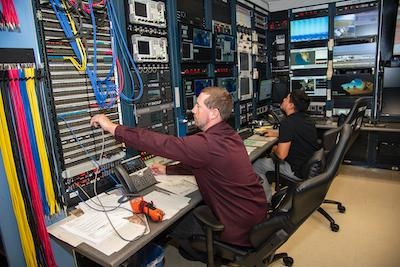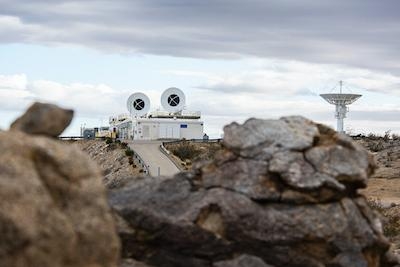Armstrong Flight Research Center Is Enhancing Its Abilities In Anticipation Of Commercial Space Flights
As the number of flights increase to the International Space Station from commercial spaceships delivering U.S. astronauts and supplies and Russian Soyuz flights continue, NASA’s Armstrong Flight Research Center in California is enhancing its abilities to be ready to help.

The center’s Dryden Aeronautical Test Range (DATR) has for decades provided backup communications for the space station and the Russian Soyuz spacecraft that currently takes U.S. astronauts to and from the space station, said Tracy Ackeret, chief of range operations.
NASA’s Commercial Crew Development program, which aims to transport U.S. and international astronauts and supplies to space by privately owned crew vehicles, periodically asks for DATR assistance in radar tracking spacecraft to confirm location. If DATR is requested, the range also is able to provide radar tracking support for landings. In addition to supporting the space station and spacecraft scheduled to visit there, the range is involved in every flight from Armstrong. That responsibility has led to enhancements to the DATR’s infrastructure to prepare for the next generation of experimental aircraft, such as the anticipated X-59 Quiet SuperSonic Technology (QueSST) aircraft.
The range began space communications involvement when the first component of the International Space Station was launched in 1998. The DATR’s primary responsibility is for communications infrastructure that has enhanced the station’s success and crew safety, Ackeret said. Upgrades continue to the Very High frequency (VHF) communications that backup the primary Space Network, which includes the Tracking and Data Relay Satellites, and communicates with the Russian Soyuz spacecraft when it is out of range of Russia
NASA’s VHF ground stations provide two-way, audio only communications and transmit over two frequencies, one for emergency communications with the station (VHF1) and the other (VHF2) for communicating with the Soyuz. Russia has its own VHF network. Working in combination, the NASA and Russian networks provide VHF communications on every orbit of the space station.
NASA's upgrades to VHF network ground antennas, currently underway, involve improvements to numerous electronic components and installation of new software for tracking the space station and Soyuz. Additionally, new antennas at the ground stations, able to operate at VHF1 and VHF2 simultaneously, will add redundancy to the network so that if one system fails, the other system will be able to take over immediately, Ackeret explained. On most Soyuz missions the spacecraft docks with the space station before exiting Russia’s VHF network coverage, as is the return to Earth. However, on missions requiring the Soyuz additional orbits to rendezvous with the space station, the NASA network stands by to provide emergency communication. When the center is called up, such as Oct. 25 when NASA astronaut Jessica Weir and two others launched in a Soyuz for the six-hour trip to the space station, the range team went to work.
Jovany Bautista raised the DATR three-story high antenna and set in motion the 18-page readiness checklist. The next set of items included powering up and checking systems and tracking software in the communications control room at the DATR Aeronautical Tracking Facility. The preparations include a voice check with NASA’s Johnson Space Center in Houston about three hours after the process begins.
NASA’s Wallops Flight Facility in Virginia, which is operated by NASA’s Goddard Space Flight Center in Maryland, provides emergency communications first as the Soyuz orbits over the Eastern U.S. and then responsibilities are passed to Armstrong as the spacecraft begins orbit over the Western U.S. Russia is responsible for providing VHF communications over Asia and Europe. Richard Batchelor, communications technician, said the range’s assets are available for 10 minutes every 90 minutes, or the amount of time it takes a spacecraft to make one orbit of the Earth.

Although Armstrong was called off once the crew safely made it to the space station, he explained that was not the case in March 2014 when communication was lost with Soyuz. An anomaly was discovered with the Soyuz rocket’s software failed to make the orbital burns to allow it to dock with the space station. In that case NASA was asked to assist in determining the Soyuz location and establish a two-way communications link between Moscow and the Soyuz to continue working the challenge as the spacecraft’s orbit entered the Western Hemisphere. Armstrong established communications between Moscow and the Soyuz, which resulted in a plan that safely brought the crew to the space station.
DATR engineers are working on interfaces with the onboard flight test instrumentation system that will permit the range to manage unique telemetry and video data formats that are new to the center, said Darryl Burkes, Range Engineering branch chief. These formats are new to the center and are needed when the X-59 begins flight testing at Armstrong. The new capabilities will permit ground processing of data acquired by flight test equipment during the Low Boom Flight Demonstration, he said. That includes real time telemetry data and video. Also included are modifications and equipment for telemetry and voice coverage of ground operations at Building 703 in Palmdale. That equipment will support early flights of the experimental aircraft at Lockheed Martin Skunk Works, also located in Palmdale.
In addition, Mobile Operation Facility 5, which is a mobile ground control room that has supported Unmanned Aircraft Systems Integration into the National Airspace System flight tests, will be modified to support X-59 ground tests at Lockheed Martin.
Range cameras on the ground, long-range optics and ramp area cameras have been updated to high definition. As a result, a new video switch was required to send that video from multiple locations to where it needs it to go. Another key upgrade is a new mission control system, which is a telemetry processing system. The enhancements will help the center meet customer requirements well into the future. “We have spent millions updating all of the systems including such items as new UHF/VHF radios in our comm facility,” Ackeret said. “The ones we had were 40 and 45 years old. Updating the video router is in progress, putting a high def camera on one of our radars, the new video switch and modifying antennas to accept C-band telemetry are going to enhance our capabilities.”
The C-band antenna enhancements are a response to changes in bandwidth availability and the range’s efforts to take advantage to newly available aeronautical bandwidth on the C-band. The range will continue to upgrade and modify to meet the needs of its customers.
“We are ready to fly when they want to fly,” Ackeret said.
(Images provided with NASA news release)
 ANN's Daily Aero-Term (04.24.24): Runway Lead-in Light System
ANN's Daily Aero-Term (04.24.24): Runway Lead-in Light System ANN's Daily Aero-Linx (04.24.24)
ANN's Daily Aero-Linx (04.24.24) Aero-FAQ: Dave Juwel's Aviation Marketing Stories -- ITBOA BNITBOB
Aero-FAQ: Dave Juwel's Aviation Marketing Stories -- ITBOA BNITBOB Classic Aero-TV: Best Seat in The House -- 'Inside' The AeroShell Aerobatic Team
Classic Aero-TV: Best Seat in The House -- 'Inside' The AeroShell Aerobatic Team Airborne Affordable Flyers 04.18.24: CarbonCub UL, Fisher, Affordable Flyer Expo
Airborne Affordable Flyers 04.18.24: CarbonCub UL, Fisher, Affordable Flyer Expo




